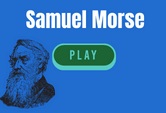Samuel Morse Game Trivia Online
This page features a Samuel Morse Game Trivia Online. It is a great exercise for students in 3rd to 9th grades. He is credited with the invention of the telegraph. He was also a famous painter and politician at some point in his life. If you want to learn more about him, the interactive game below comes in handy. It contains 15 questions about Samuel Morse which hinge on interesting facts about his life. Click the start button to play. Remember this is a great classroom game to be played alone or in groups. Answer keys are embedded within and feedback is instant as you play. Have fun learning.

Samuel Morse, who is often credited with developing the telegraph, was an American inventor and painter. He influenced the development of a single-wire telegraph system based on the telegraphs used in Europe. Although Morse is best remembered today for his inventions, he also had a political career and sketched some famous paintings. To learn more about Morse, read the article below.
Samuel F. B. Morse
Samuel Finley Breese Morse was born in Charlestown, Massachusetts, the first son of Reverend Jedidiah and Elizabeth Ann Finley Morse. His parents firmly believed in the value of an education and in the power of a strong, central government. Samuel attended Phillips Academy and Yale College, and while there he developed a passion for painting. While at Yale, he focused on the field of art, focusing on figurative work as a means of capturing a subject's essence.
In 1809, at the age of 14, Samuel Morse went to Yale College and studied art. He took a course in electricity and attended lectures by Benjamin Silliman and Jeremiah Day. He continued to paint, and in 1810 was appointed Professor of Painting and Sculpture at the University of the City of New York. A year later, while still at Yale, Morse overheard a conversation about electromagnets and conceived the idea for an electrical telegraph.
His invention
The single-wire telegraph was Samuel Morse's invention. In 1832, he drafted initial ideas for an electric telegraph and continued working on it alone for several years. In 1837, Morse was prompted by congressional interest in semaphore telegraphy to propose a superior system. The result was the first telegraph. After two years of testing, Morse's electric telegraph was accepted as a national landmark and was officially named the Morse telegraph.
In addition to his studies at Yale, Morse became an amateur artist, painting portraits of important citizens, such as John Adams. He also produced a number of his own works of art, including many famous paintings.
His political career
Before launching his political career, Samuel F.B. Morse attended Yale College and Phillips Academy in Massachusetts. In addition to studying mathematics and the sciences, he supported himself by selling paintings and drew portraits of family and friends to support himself. While at Yale, he enrolled in a broad course of study, including art and geography.
The Nativist movement was a forceful force in Morse's political career. He opposed Catholicism and joined the movement to make America more like Europe. He considered the immigrant poor ignorant and "Romish." His anti-Catholic politics cost him a resounding defeat in the 1836 election. His political career would eventually be defined by his anti-Catholic stance.
His sketching
In 1829, Samuel Morse left New Haven to go on a three-year tour of Europe. He sketched old masters, studied their paintings, and produced his own paintings. While in Europe, he painted a large mural for the Louvre, which is in the Terra Museum of American Art, Chicago. Although his work drew positive criticism among the intellectual class, it did not impress the American public. After his return, the Congressional Committee on Public Buildings humiliated him and refused to commission a mural for the Capitol Rotunda.
In 1813, Samuel Morse studied art in England. He was soon exhibiting his work at the Royal Academy of Arts. In the next few years, he became an itinerant painter, living from one city to the next. Once he settled in New York, he began to paint portraits and commissioned portraits of former presidents and prominent Charleston merchants. While he was painting portraits, he infused his paintings with Romanticism.
His relationship with a second cousin
A fascinating relationship between Samuel Morse and his second cousin emerged during the nineteenth century. Morse had a complicated background, beginning with his early anti-Catholic and anti-immigrant politics. As one of the foremost supporters of the anti-immigrant Nativist Party, he unsuccessfully ran for the office of New York Mayor in 1836. After the election, he teamed up with Cyrus Field to lay telegraph lines across the Atlantic, eventually becoming one of the richest men in the world.
In 1847, he bought an estate near Poughkeepsie, New York, and started to build a mansion there. This mansion was designed to be an Italian villa. Morse spent the summers on the estate with his large family, and returned to his brownstone house in New York City during the winter. It is unclear what his relationship with his second cousin was like, but it certainly was not pleasant.
